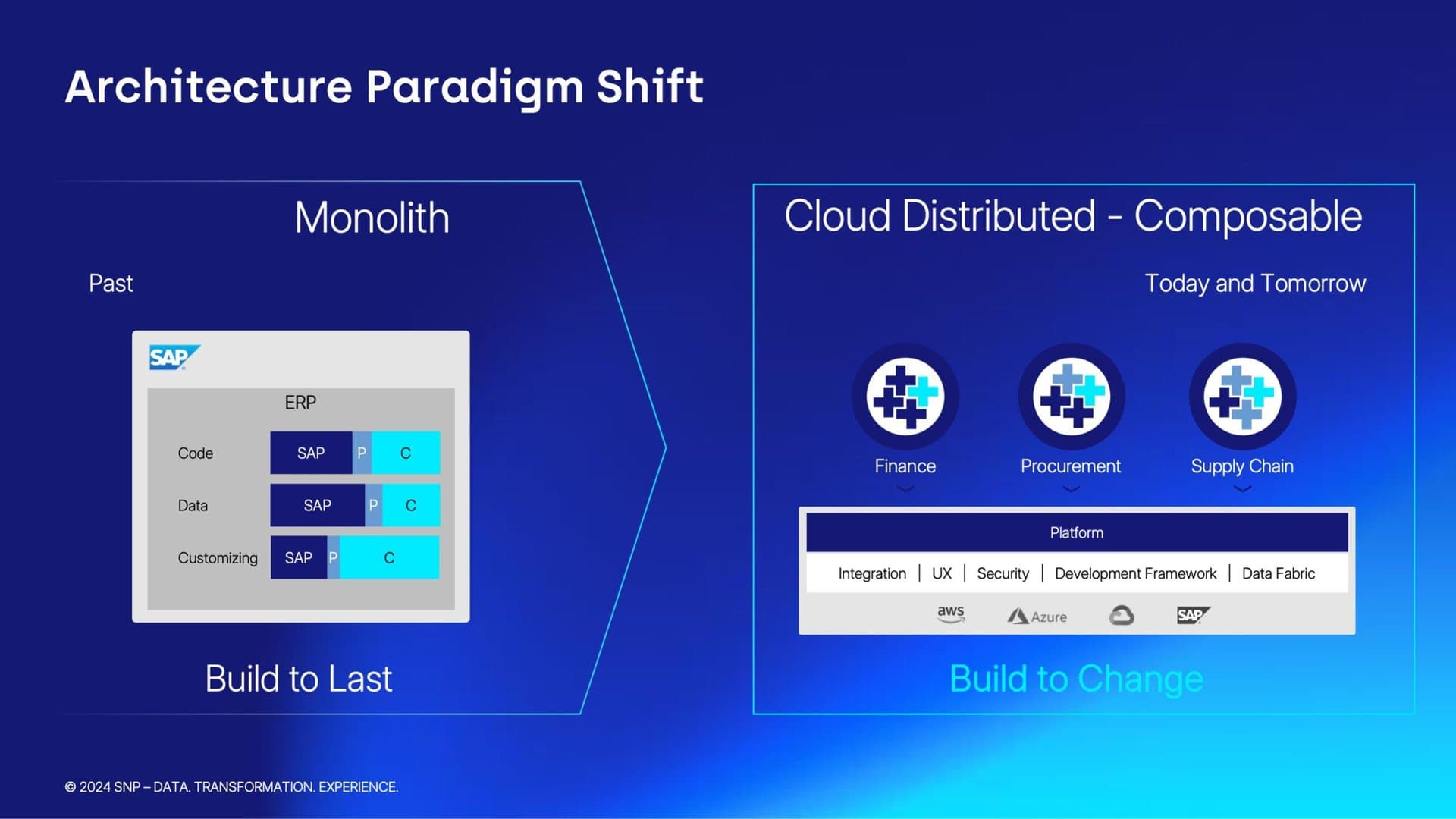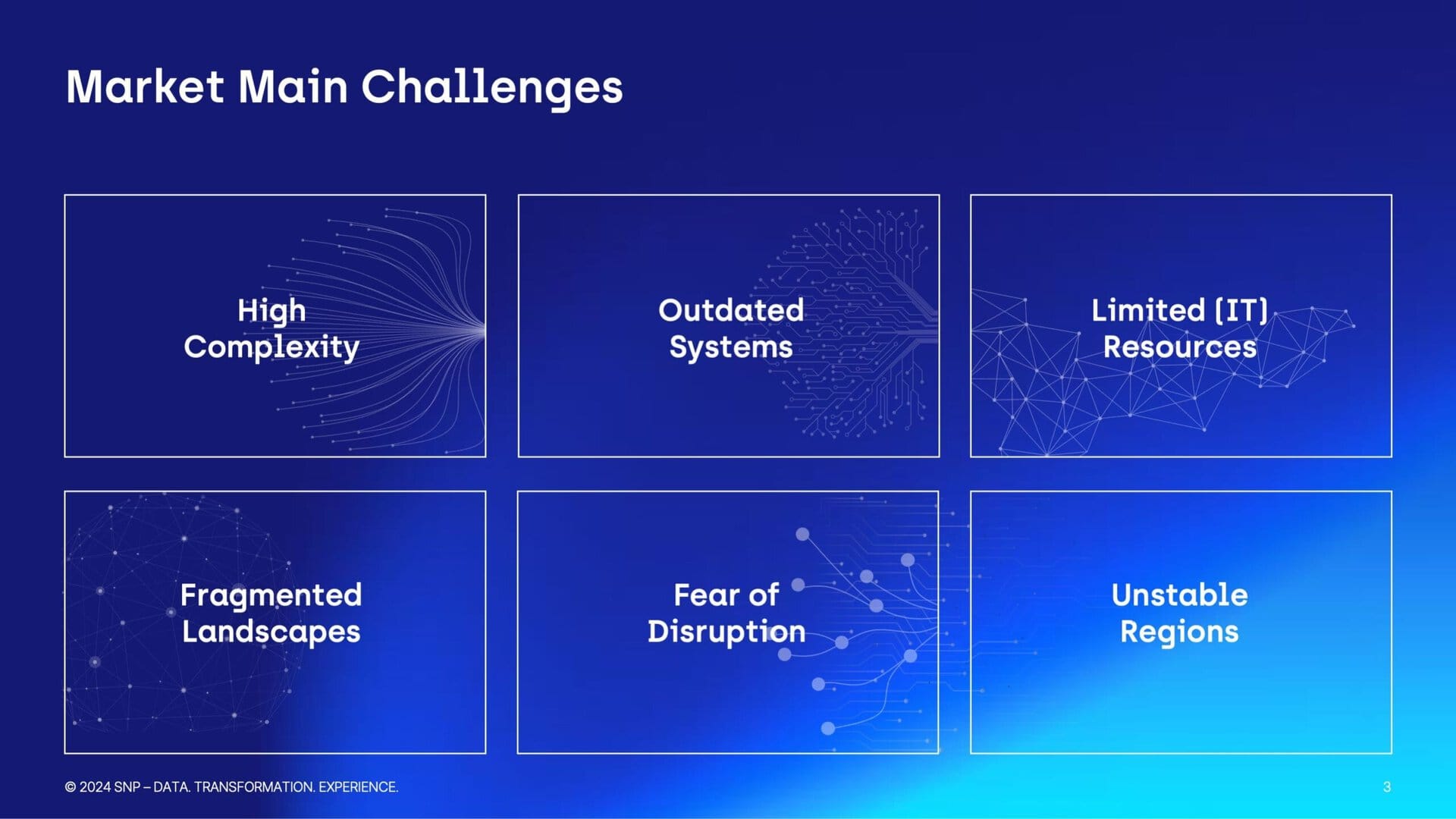Always keep moving


If you look at the challenges that companies have faced over the last decade and a half, you know how draining times must have been for them since then. The global financial crisis, geopolitical and economic changes, climate change, the pandemic, the wars in Ukraine and the Middle East, a shortage of skilled workers. The result: shrinking sales markets, a changed "order" due to new alliances such as the BRICS states, stricter guidelines and laws, unstable supply chains, withdrawal from markets, the desperate search for personnel. As if that were not enough, technological challenges have been and continue to be added.
Industry 4.0 with digitalization and IIoT, big data, cloud computing, artificial intelligence. Companies have to cope with large initial investments and ongoing costs, staff adjustment difficulties, cyber security and data protection. SAP user companies have also been preparing to move their systems since the announcement of the new ERP software solution and database technology S/4HANA in 2015. Complex projects that can involve several hundred systems and huge amounts of data for multinational corporations. Does it read like the beginning of a horror novel? It's more like a travelogue.
Of course, the scene is set in the mountains, with plenty of altitude to conquer. But once you arrive, you are rewarded with an incomparable view as far as the horizon. Not only is the effort worthwhile, but help is also available for part of the route. For the comfortable ascent in the mountains, there are cable cars. For their journey to a modern and agile composable business, companies can rely on specialists in IT and business transformation.
Check-up and fitness plan
Once the decision has been made to make the company fit for the future - and it is better to do this sooner rather than later in view of the challenges - important decisions need to be made. If a person wants to get fit, healthy and resilient again with a strict diet and exercise plan, they need to have a thorough check-up beforehand to ensure that the plan works and doesn't backfire. It's no different with IT systems.

Over the years, they can grow into colossi with a lot of ballast. In-house developments in SAP systems, for example, make migration to SAP S/4HANA more difficult. For many companies, the extensions allow SAP systems to be customized in order to adapt standard functions to individual business requirements. While these custom developments are often necessary to map specific business processes, they can also pose significant challenges and problems: Many custom codes are not compatible with the new SAP S/4HANA architecture, which can make migration to this platform complex and expensive. In-house developments that are optimized for on-premises systems may not be compatible with cloud-based solutions. This can make the introduction of SAP cloud products such as SAP Business Technology Platform (BTP) more difficult.
A look at the interfaces also helps. If scans show that the number of interfaces assumed by the customer is many times higher, this should alert them: It makes a difference whether you think you have an overview of 2,000 interfaces but have actually lost it over 11,000. Particularly in complex environments such as SAP systems, where there are numerous interfaces between different modules, systems and external applications, unknown interfaces pose a risk to the stability, security and efficiency of the systems.
Two examples that show that every modernization and transformation project starts with a thorough check-up. Once the investigations have been carried out and the current situation is clear, a plan can be drawn up and the method selected. Tailored specifically to the conditions and objectives of the company, a brown, green or the flexible Bluefield data migration approach is chosen, public or private cloud or even a hybrid solution, a decision is made as to which data can continue to be used and which can be archived, etc.
Sparring partner software with X-ray vision and foresight
These are in-depth interventions in complex SAP landscapes that take place as part of an IT and business transformation, and companies need an experienced partner who knows their pain points and current challenges, but also has the foresight for the future. With its software, it can look deep into the systems, create analyses and forecasts and accompany every step of the data migration and business transformation, right from the start. Today, it is no longer "just" about data migration.
When it comes to future business agility and the development from a monolithic system with data, codes and custom codes to a composable business with modular individual systems, a modern software platform is needed that offers an end-to-end solution for digital transformation with its functionalities. This also includes the solutions of technology partners and system integrators, for example, which supports customers with the aforementioned custom code management and clean core strategy.
"Clean Core" aims to keep the SAP system as close as possible to the standard functions and to make adjustments and enhancements outside the core system. This is particularly important for SAP S/4HANA, where the aim is to take advantage of innovations and updates without major disruptions. Any modification to the core can lead to problems with updates and maintenance. Adjustments that are necessary should be made outside the core system, for example by using extension and integration mechanisms.
Customizations and extensions can be made via SAP BTP, which enables decoupling from the core system. Side-by-side extensions can be developed and operated in separate systems that communicate with the SAP core system via APIs (Application Programming Interfaces). This keeps the core clean. The clean core concept helps to reduce complexity and simplify the system landscape while remaining flexible, innovative, agile and competitive.
Always one step ahead, fast and flexible
The sparring partner focuses on the central aspects and principles of the Composable Enterprise. The business model focuses on modularity and flexibility by breaking down its digital and business capabilities into independent, reusable building blocks that can be quickly combined, adapted and reassembled to respond to changing market requirements. The concept offers several advantages. It is flexible and adaptable. As the individual components are developed and operated independently of each other, companies can react quickly to changes in the market, in technology or in customer requirements. New modules can be integrated quickly or existing modules adapted without having to rework the entire system.
You can scale individual components independently of each other to meet different requirements. This enables targeted and cost-efficient use of resources. Components and services can be reused in different contexts and for different applications. This reduces development effort and costs, as not everything has to be developed from scratch every time. The reusability and modularity also lead to lower development and maintenance costs, as components that have been developed once can be used in different projects.

By combining prefabricated modules, companies can bring new products and services to market more quickly. This is particularly beneficial in highly competitive industries where time is of the essence. As companies can experiment and test new modules or technologies more easily, the composable enterprise model promotes innovation. New ideas can be implemented quickly and, if successful, developed further. The modular nature of a composable enterprise makes it easier to integrate new technologies and systems. Existing systems can be replaced with new, more suitable modules without having to overhaul your entire IT infrastructure.
They can combine and exchange modules from different providers, which reduces dependencies on a single provider and offers more flexibility in selecting the best solutions. By combining different modules, companies can offer customized solutions that are better tailored to the individual needs of their customers. This increases customer satisfaction and strengthens customer loyalty. The modular structure makes it possible to react more quickly to customer feedback and make adjustments to products or services. As individual modules can be developed and tested separately, the risk associated with the introduction of new technologies or products is lower. Companies can proceed step by step and make adjustments as required. The modular architecture makes it possible to make continuous improvements without massively disrupting existing systems or processes.
Business agility and the concept of the composable enterprise offer significant advantages in terms of flexibility, efficiency and innovation. It enables companies to react more agilely to market changes, reduce costs and increase customer satisfaction at the same time. In an increasingly dynamic and competitive business world, the composable enterprise is therefore a key success factor. There are plenty of current examples of companies having to react quickly. One scenario is carve-outs due to geopolitical challenges.
Rapid retreat - example of deglobalization
If there is increased economic volatility and disruption to supply chains in times of global crisis or war, the disposal of non-core or high-risk assets can help to reduce vulnerability to complications and allow the company to continue to focus on its core business. A company's financial resources can also be strained. Then, divesting underperforming or non-essential assets can provide the liquidity needed to weather the crisis and invest in more promising opportunities. Strategic priorities may need to be realigned.
By selling certain units, the focus can be placed on areas that are more resilient or have better growth prospects. Companies operating internationally can become targets in the event of conflicts or geopolitical tensions or face challenges due to their connection to certain countries or regions. To minimize the risks, some choose to reduce their exposure in vulnerable areas. Crises also influence consumer behavior, demand patterns and market dynamics.
A divestiture can then help companies to reposition themselves in order to meet changing market requirements and take advantage of new opportunities. Last but not least, resources, including employees and capital, may need to be reallocated in order to respond to the challenges. These resources can be freed up through the sale of units.
The decision to divest is a very complex one and is influenced by various factors. Companies must carefully weigh up the potential advantages and disadvantages. However, carving out and migrating the data of the unit to be divested must be part of the considerations and planning from the outset. Whatever the reason for a carve-out, there is no doubt that it is one of the most complex tasks a company has to deal with.
This is not only about managing the organizational and process-related changes, but also about the difficulty of finding a carve-out plan that is perfectly tailored to the company. We very often see that companies have a certain basic understanding of the processes and operational interdependencies, but not in detail. For a smooth carve-out, they need to invest and really master their operational complexities. And they need to bring in experts to support them right from the start.

Conclusion:
The most successful companies are those that are able to adapt quickly, respond to new challenges without delay and constantly evolve to create added value for their customers. It's a big task, but one for which companies can call on a partner. An experienced mountain guide who will lead them safely to the top.






